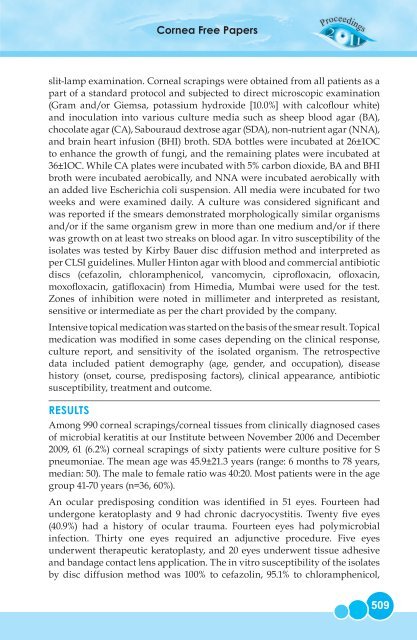Cornea - I Free Papers - aioseducation
Cornea - I Free Papers - aioseducation
Cornea - I Free Papers - aioseducation
You also want an ePaper? Increase the reach of your titles
YUMPU automatically turns print PDFs into web optimized ePapers that Google loves.
<strong>Cornea</strong> <strong>Free</strong> <strong>Papers</strong><br />
slit-lamp examination. <strong>Cornea</strong>l scrapings were obtained from all patients as a<br />
part of a standard protocol and subjected to direct microscopic examination<br />
(Gram and/or Giemsa, potassium hydroxide [10.0%] with calcoflour white)<br />
and inoculation into various culture media such as sheep blood agar (BA),<br />
chocolate agar (CA), Sabouraud dextrose agar (SDA), non-nutrient agar (NNA),<br />
and brain heart infusion (BHI) broth. SDA bottles were incubated at 26±1OC<br />
to enhance the growth of fungi, and the remaining plates were incubated at<br />
36±1OC. While CA plates were incubated with 5% carbon dioxide, BA and BHI<br />
broth were incubated aerobically, and NNA were incubated aerobically with<br />
an added live Escherichia coli suspension. All media were incubated for two<br />
weeks and were examined daily. A culture was considered significant and<br />
was reported if the smears demonstrated morphologically similar organisms<br />
and/or if the same organism grew in more than one medium and/or if there<br />
was growth on at least two streaks on blood agar. In vitro susceptibility of the<br />
isolates was tested by Kirby Bauer disc diffusion method and interpreted as<br />
per CLSI guidelines. Muller Hinton agar with blood and commercial antibiotic<br />
discs (cefazolin, chloramphenicol, vancomycin, ciprofloxacin, ofloxacin,<br />
moxofloxacin, gatifloxacin) from Himedia, Mumbai were used for the test.<br />
Zones of inhibition were noted in millimeter and interpreted as resistant,<br />
sensitive or intermediate as per the chart provided by the company.<br />
Intensive topical medication was started on the basis of the smear result. Topical<br />
medication was modified in some cases depending on the clinical response,<br />
culture report, and sensitivity of the isolated organism. The retrospective<br />
data included patient demography (age, gender, and occupation), disease<br />
history (onset, course, predisposing factors), clinical appearance, antibiotic<br />
susceptibility, treatment and outcome.<br />
RESULTS<br />
Among 990 corneal scrapings/corneal tissues from clinically diagnosed cases<br />
of microbial keratitis at our Institute between November 2006 and December<br />
2009, 61 (6.2%) corneal scrapings of sixty patients were culture positive for S<br />
pneumoniae. The mean age was 45.9±21.3 years (range: 6 months to 78 years,<br />
median: 50). The male to female ratio was 40:20. Most patients were in the age<br />
group 41-70 years (n=36, 60%).<br />
An ocular predisposing condition was identified in 51 eyes. Fourteen had<br />
undergone keratoplasty and 9 had chronic dacryocystitis. Twenty five eyes<br />
(40.9%) had a history of ocular trauma. Fourteen eyes had polymicrobial<br />
infection. Thirty one eyes required an adjunctive procedure. Five eyes<br />
underwent therapeutic keratoplasty, and 20 eyes underwent tissue adhesive<br />
and bandage contact lens application. The in vitro susceptibility of the isolates<br />
by disc diffusion method was 100% to cefazolin, 95.1% to chloramphenicol,<br />
509

















